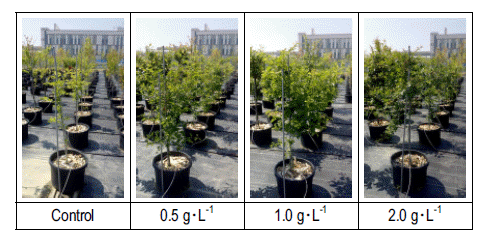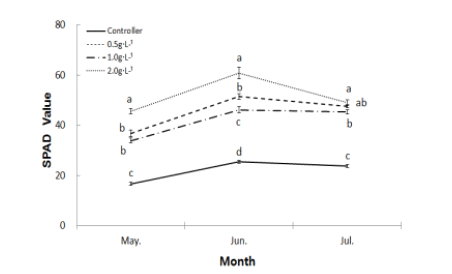Bayala, J, M Dianda, J Wilson, SJ Ouedraogo, K Sanon. Predicting field performance of five irrigated tree species using seedling quality assessment in Burkina Faso, West Africa. New For. 2009. 38(3):309-322.

Cho, MS, SW Lee, JH Bae, GS Park. Effect of different fertilization on physiological characteristics and growth performances of Eucalyptus pellita and Acacia mangium in a container nursery system. J. Bio-Environ. Control. 2011. 20(2):123-133.
Cho, YH A comparison of the growth of woody landscape plants in cultivation method using container. MS thesis. 2014. Honam Univ, Gwangju, Korea.
Dickson, A, AL Leaf, JF Hosner. Quality appraisal of white spruce and white pine seedlings stock in nurseries. For. Chron. 1960. 36(1):10-13.

Han, SH, JK Byun, MS Cho, JY An, GS Park, SB Kim, BB Park. The effects of 7 fertilizers on the growth and nutrient concentrations of Fraxinus rhynchophylla, Fraxinus mandshurica, Pinus koraiensis, and Abies holophylla seedlings. J. Korean For. Soc. 2016. 105(2):177-185.

Hwang, JH, MS Cho, AR Yang, SK Kim. Effects of fertilization on the physiological characteristics and growth performances of container seedlings of Torreya nucifera. Korean Inst. For. Recreat. Jeju Korea.. 2013. 4;
Hwang, JO, YH Son, MJ Yi, JK Byoung, JH Jung, CY Lee. Studies on relationship between composition and type of fertilizer and seedling (I. Influence on biomass, specific leaf area and chlorophyll content). For. Bioenergy. 2003. 22(2):44-53.
Kang, HC, KK Shim, YM Ha, WH Lee. New varieties ith thornless branches of Crataegus pinnatifida Bunge. Korea J. Hort. Sci. Technol. 2002. 20(3):252-256.
Kang, SB, IB Lee, TJ Lim, JM Park. Effect of nitrogen fertigation by soil testing on the growth and yield of 'Campbell Early' (Vitis labrusca L.) grapevine in field cultivation. Korean J. Environ. Agric. 2010. 28(4):12-19.

Kang, TH Study on a tree production technique that used by container. MS thesis. 2008. Pusan National Univ, Pusan, Korea.
Kang, YG Influence of nitrogen application rate on growth and dry matter yield of Achyranthes japonica Nakai. Korean J. Med. Crop Sci. 2003. 11(2):109-114.
KFS (Korea Forest Service). Statistical yearbook of forestry 2006 Korea Forest Service; Daejeon, Korea. Retrieved from
http://www.forest.go.kr/.
KFS (Korea Forest Service). Statistical yearbook of forestry 2016 Korea Forest Service; Daejeon, Korea. Retrieved from
http://www.forest.go.kr/.
Kim, DU, MS Kim. Effects of root restriction by clay pot and root control bag on growth of Acer palmatum. J. Korean Inst. Landsc. Archit. 2000. 28(4):1-8.
Kim, MH, JC Shin, BW Lee. Applicability of vegetation index and SPAD reading to nondestructive diagnosis of rice growth and nitrogen nutrition status. Korean J. Crop Sci. 2005. 50(6):369-377.
Kim, MH, JD Fu, BW Lee. Determining nitrogen topdressing rate at panicle initiation stage of rice based on vegetation index and SPAD reading. Korean J. Crop Sci. 2006. 51(5):386-395.
Kim, TJ, HB Kim. Study on the container versus traditional landscape tree production methods: Economic feasibility study. Collect. Diss. 1999. 31:171-178.
Kimmins, JP Forest ecology: a foundation for sustainable management 1997. (2th ed.). New Jersey, USA: Prentice Hall, Inc.
Kwon, KW, JH Lee. Growth performances and physiological responses of Quercus spp. and Fraxinus rhynchophylla subjeted to different soil moisture regimes and nutrition levels. J. Korean For. Soc. 1994. 83(2):164-174.
Kwon, KW, MS Cho, GN Kim, SW Lee, KH Jang. Photosynthetic characteristics and growth perfomances of containerized seedling and bare root seedling of Quercus acutissima growing at different fertilizing schemes. J. Korean For. Soc. 2009. 98(3):331-338.
Kwon, YH, SJ Kim, HK Oh, SK Han, SJ Kim. Effects of media kinds and container forms for urban agriculture on the growth characteristics of several herbaceous and woody plants. J. Korean Soc. People Plants Environ. 2016. 19(5):477-486.

Le Bail, M, MH Jeuffroy, C Bouchard, A Barbottin. Is it possible to forecast the grain quality and yield of different varieties of winter wheat from Minolta SPAD meter measurements? Eur. J. Agron. 2005. 23(4):379-391.

Lee, CY Characteristics of photosynthesis with growing stages by different shading materials in Panax ginseng C. A. Meyer. Korean. J. Med. Crop Sci. 2007. 15(4):276-284.
Lee, SW, JH Choi, SK Yoo, SK Kim, JH Bae, HS Kyo. Effect of raw material properties on growth characteristics of broad-leaved container seedlings. J. Bio-Environ. Control. 2006. 15(3):244-249.
Lee, HJ Studies on root development of root cutting seedlings of Aralia elata seemann grown in plastic netting container. MS
thesis. 2002. Konkuk Univ, Chungju, Korea.
Loh, FC, JC Grabosky, NL Bassuk. Using the SPAD 502 meter to assess chlorophyll and nitrogen content of Benjamin fig and cotton wood leaves. HortTechnology. 2002. 12(4):682-686.

Park, YJ Growth characteristics of landscape trees on the size of nonwoven fabric container. J. East Coast. Res. 1999. 10(2):49-63.
Piekielek, WP, RH Fox, JD Toth, KE Macneal. Use of a chlorophyll meter at early dent stage of corn to evaluate nitrogen sufficiency. Agron. J. 1995. 87(3):403-408.

Son, IK A study on the improvement scheme on tree production technology using containers. MS thesis. 2013. Kongju National Univ, Kongju, Korea.
Sung, HI, KS Song, YG Cha, JJ Kim. Characteristics of growth and seedling quality of 1-year-old container seedlings of Quercus myrsinaefolia by shading and fertilizing treatment. J. Korean For. Soc. 2011. 100(4):598-608.
Yoon, HG, SH Oh, KH Kwon, JT Jang, JS Seo. Effect of nitrogen concentration on fruit cracking in 'Kyoho' grape. Korean Soc. Hortic. Sci. Jeju Korea. 2005. May;
Yoon, TS, SG Hong. Studies on production of plastic net container seedlings of Hovenia dulcis Thunb. J. Agric. Resour. Dev. 2002. 24:43-48.










